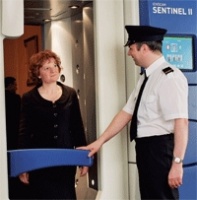
The technique, known as Proton Transfer Reaction Mass Spectrometry (PTR-MS), has been developed to provide real-time analysis of very low vapour pressure explosives that are hard to detect in their gas state using existing methods.
Prof Christopher Mayhew at Birmingham University believes advances in the technology could mean it will replace existing homeland security chemical sensors within the next year.
‘We’re at a crucial stage of development,’ Mayhew said. ‘Improvements in resolution and accuracy in the past two years have meant that we can now apply it to a much wider range of applications. In particular, we believe security screening will benefit considerably.’
Unlike other chemical-detection technologies, PTR-MS does not distinguish between substances using its associated by-products, which can sometimes originate from harmless sources such as perfume or fuel. Instead, it uses H3O+ ions that only react with specific volatile agents on contact in the air. The reaction causes H3O+ to donate its proton to the agent, increasing its mass by one atomic unit. Once this ionisation process occurs, the agent can be singled out and marked as a threat.
Recent advances in PTR-MS have included the introduction of time-of-flight spectrometry to analyse suspicious molecules. This technique separates the ions according to their mass-to-charge ratio at an accuracy that is enough to distinguish between molecules with the same chemical weight.
The increase in accuracy has led researchers at Birmingham University to team up with Innsbruck University spin-out Ionicon and defence firm Smiths Detection to develop a standalone security screening system.
Mayhew envisages the final system to be a walk-through portal that blows a steady stream of air over a passenger’s body. The air will dislodge particles, which are trapped within a filter system and then taken in through an inlet where the ionisation process takes place.
The technology uses H3O+ ions that only react with specific volatile agents on contact in the air
Mayhew said: ‘What we don’t really have is the proper inlet systems to give us a fast cycle time. At the moment, we’re still detecting signals up to 10 minutes after we put explosives in and that’s no good in practical terms. We’ve put in an EU grant to get PhD students to help with the inlet system — we are hoping to reduce the cycle time to 30 seconds or less.’
The team is also hoping to use the same technology to develop a breathalyser for use in the early detection of diseases. This will pick up VOCs on the breath, which could provide early diagnosis of illnesses such as cancer.
Mayhew added that further applications could include research to analyse emissions from plants and in food science to understand the relationship between flavour release and perception. ‘I can see this technology opening up wide areas of atmospheric research where volatile organic compounds are being emitted in trace quantities.’










CCC Report Finds UK Climate Targets Still Within Reach
In 1990 67% of the UK´s electricity came from coal-fired power stations and even without renewables the transition to gas was a major contributor to...